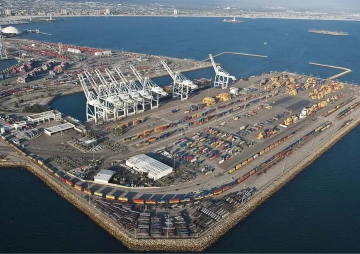Naxalite violence in Andhra Pradesh has been on the rise ahead of the elections to the State legislature and Parliament. The violence has been particularly scary and political leaders, especially belonging to the ruling Telugu Desam Party (TDP) and its electoral ally, the BJP, are being targeted.
The highest ranking political leader to fall prey to the PWG's bullet was M Venkata Raju, husband of Minister for Tribal Welfare Manikumari. Raju was shot dead by an action team of the People's War Group (PWG) at point blank range in Paderu, Visakhapatnam district, on March 18. Claiming responsibility for the murder, the Andhra-Orissa Border Special Zone Committee (AOBSZC) of the PWG, media reports said on March 24, accused Raju of supporting the anti-tribal policies of the government and declared he was killed because he was an "important" TDP leader. Evidently, the Naxalites were hoping to attract publicity by indulging in a high-profile murder. The killing has understandably sent shock waves across the State and especially in the north coastal region. In all, in 2003, 55 political leaders-nine from the BJP, 41 belonging to the TDP, four from the Congress and an independent-lost their lives to Naxalite violence in the State. Between November 14, 2003, when the Legislative Assembly was dissolved, and late-March 2004, at least 32 politicians were shot dead by the PWG in the State.
There is a perceptible change this time round in the attitude of the PWG towards the elections. During the previous elections, the PWG consistently gave a boycott call. This time, it has asked its cadres to disrupt the elections at all stages and indulge in targeted killings of the local-level leadership of the TDP and the BJP, and put on notice leaders of other political parties, including from the Congress. In an internal circular issued in February, the PWG said: 'we would permit the opposition parties to conduct campaign work, but we should expose them politically'.
Besides, a noticeable feature of the ongoing spate of violence is that it is focused on the north coastal parts of the State, which fall under the jurisdiction of the AOBSZC. Within the State, the north coastal region is relatively new to PWG violence, whereas north Telengana has been a perennial victim since the past 24 years. In the first place, the Naxalites would not have grown stronger and bolder, nor would they have achieved a new presence in hitherto unknown areas in coastal Andhra Pradesh and Rayalaseema, if the government had not encouraged a policy of surrender and rehabilitation, rather than keeping up the pressure on them.
The present shift in the scene of action to AOBSZC area is a result of a well thought out tactical move by the PWG. The outfit has suffered severe reverses in north Telengana following the killing in encounters with the police of senior and able leaders like Anupuram Komaraiah 'AK', Polam Sudarshan Reddy 'RK', Nelakonda Rajitha 'Padma' and a few other district-level leaders and squad commanders. As a result, the PWG has been weakened in its traditional stronghold and has been making fervent attempts to regain ground. Thus, this new wave of violence in the AOBSZ area is part of the tactical counter offensive campaign (TCOC) in that direction.
The PWG plan is to shift the focus of attention to north coastal Andhra, engage the police in clashes and tie it down to the region, while it would attempt to retrieve lost ground in north Telengana. Moreover, the police in AOBSZ region has neither the required levels of training nor the capability to foresee, as well as effectively tackle, PWG violence. Indeed, the location and the terrain there serve as additional advantages for the PWG. Interior parts of the region are not easily accessible, dotted as they are with hillocks, and are also close to the nearly impregnable jungles in the tri-junction between Andhra, Orissa and Chhattisgarh.
The impact of the fear that the PWG has been able to generate through its reckless killing of some political leaders while sternly warning some others to resign from their posts has been quite significant. Twenty-two district and local-level party functionaries and elected representatives of the TDP resigned from their posts, in mid-March, in East Godavari district, which had never in the past witnessed any noticeable level of PWG violence or activity. In the Naxalite strongholds, the number of resignations has been countless and leaders have either been warned not to venture into affected villages without providing prior information to the police or have been advised to take adequate precautions to protect their lives. In fact, the Karimnagar district police has been sending advisories to targeted political leaders through SMS on cellular phones and have issued a booklet, Sanjeevini, containing tips to evade armed PWG squads, a move that has been replicated with considerable success in various parts of the State.
In the wake of rising Naxalite violence and the fear that it would reach a crescendo as polls advance, the State requested for massive deployment of central para-military forces. Reportedly, 153 companies would be deployed in different parts of the State, a month ahead of the elections. Half of these have already reached the State. These are in addition to the 89,000-strong State police and another 20,000 uniformed personnel from the other departments in the State. The massive buildup of police forces clearly points towards bloodier days. The heavy presence of the police would have a considerable measure of psychological impact on the PWG. The outfit might, therefore, seek to perform some high-profile actions. Moreover, the slightest negligence on the part of the police on election duty might have disastrous, and sometimes even fatal, consequences.
Gripped by the fear of violent retribution, political campaigning has been on a low key in the Naxalite-affected parts of the State. Further, as local-level leaders have relocated themselves to safer places like a nearby town or the district headquarters, there now prevails an uneasy vacuum in the villages. These leaders are important agents of political mobilisation and their absence has, thus, adversely affected it. On the other hand, the Naxalites are either present or can make their presence felt in those areas. Thus, they have the ability to influence political developments in some villages. It is, therefore, likely that the Naxalites would strike clandestine deals with one or the other political party in their areas of influence and help its candidate during the elections. They would, thus, in a way, act like local warlords and arbiters in the battle for the ballot. Hence, it is doubtful if elections in some constituencies would be entirely free and fair and, as a result, the final outcome would not represent true choice.
These new set of linkages would, perhaps, influence in considerable measure the policy of the next political dispensation in the State towards the Naxalites.
* Views expressed in this article are those of the author and do not necessarily reflect those of Observer Research Foundation.
The views expressed above belong to the author(s). ORF research and analyses now available on Telegram! Click here to access our curated content — blogs, longforms and interviews.




 PREV
PREV

